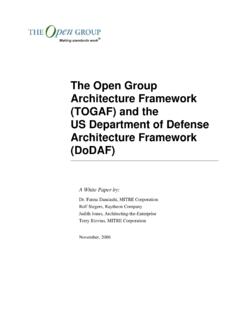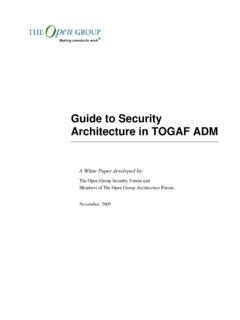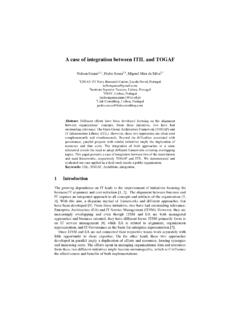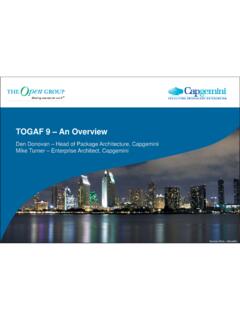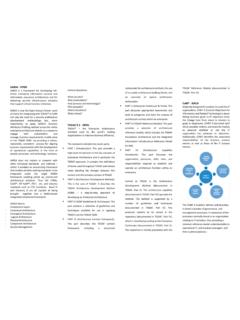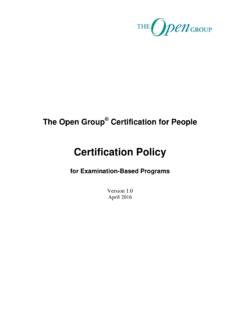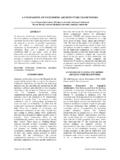Transcription of TOGAF™ Version 9 Enterprise Edition - immagic.com
1 togaf Version 9 Enterprise Edition An Introduction A White Paper by: Andrew Josey, The open group January, 2009 An Introduction to togaf 9 A White Paper Published by The open group 2 Copyright 2009 The open group All rights reserved. No part of this publication may be reproduced, stored in a retrieval system, or transmitted, in any form or by any means, electronic, mechanical, photocopying, recording, or otherwise, without the prior permission of the copyright owners. The views expressed in this document are not necessarily those of any particular member of The open group . In the event of any discrepancy between text in this document and the official togaf 9 documentation, the togaf 9 documentation remains the authoritative Version for certification, testing by examination, and other purposes. The official togaf 9 documentation can be obtained online at Boundaryless Information Flow and togaf are trademarks and Making Standards Work , The open group , UNIX , and the X device are registered trademarks of The open group in the United States and other countries.
2 All other trademarks are the property of their respective owners. togaf Version 9 Enterprise Edition : An Introduction Document No.: W094 Published by The open group , January 2009. Any comments relating to the material contained in this document may be submitted to: The open group 44 Montgomery St. #960 San Francisco, CA 94104 or by email to: An Introduction to togaf 9 A White Paper Published by The open group 3 Contents Executive 4 Introduction to togaf 5 What is architecture in the Context of togaf ?..5 What kinds of architecture does togaf deal with?..5 Structure of the togaf What does togaf Contain?.. 7 architecture Development Method (ADM)..7 ADM Guidelines and architecture Content Enterprise togaf Reference architecture Capability What s New in togaf Version 9?.. 9 Modular Content Extended Architectural Additional ADM Further 11 About the 11 About The open 11 An Introduction to togaf 9 A White Paper Published by The open group 4 Boundaryless Information Flow achieved through global interoperability in a secure, reliable, and timely manner Executive Summary This document provides an introduction to togaf 9.
3 Topics addressed include: An Introduction to togaf togaf , its structure and content The kinds of architecture that togaf addresses What s new in togaf 9 An Introduction to togaf 9 A White Paper Published by The open group 5 Introduction to togaf 9 togaf is an architecture framework The open group architecture framework . Put simply, togaf is the de facto global standard for assisting in the acceptance, production, use, and maintenance of architectures. Practical and proven, it is based on an iterative process model supported by best practices and a re-usable set of existing architectural assets. togaf is developed and maintained by The open group architecture Forum and its 350 members. The first Version of togaf , developed in 1995, was based on the US Department of Defense Technical architecture framework for Information Management (TAFIM). Starting from this sound foundation, The open group architecture Forum has developed successive versions of togaf at regular intervals and published each one on The open group public web site.
4 This document covers togaf Version 9, referred to as togaf 9 within the text of this document. togaf 9 was first published in January 2009. togaf 9 is an evolution from togaf and a description of the changes is provided in Section togaf 9 can be used for developing a broad range of different Enterprise architectures. togaf complements, and can be used in conjunction with, other frameworks that are more focused on specific deliverables for particular vertical sectors such as Government, Telecommunications, Manufacturing, Defense, and Finance. The key to togaf is the method the togaf architecture Development Method (ADM) for developing an Enterprise architecture that addresses business needs. What is architecture in the Context of togaf ? ISO/IEC 42010:20071 defines architecture as: The fundamental organization of a system, embodied in its components, their relationships to each other and the environment, and the principles governing its design and evolution.
5 togaf embraces and extends this definition. In togaf , architecture has two meanings depending upon the context: 1. A formal description of a system, or a detailed plan of the system at a component level to guide its implementation 2. The structure of components, their inter-relationships, and the principles and guidelines governing their design and evolution over time What kinds of architecture does togaf deal with? togaf 9 covers the development of four related types of architecture . These four types of architecture are commonly accepted as subsets of an overall Enterprise architecture , all of which togaf is designed to support. They are shown in Table 11 ISO/IEC 42010:2007, Systems and Software Engineering Recommended Practice for Architectural Description of Software-Intensive Systems, Edition 1 (technically identical to ANSI/IEEE Std 1471-2000). An Introduction to togaf 9 A White Paper Published by The open group 6 Table 1: architecture Types Supported by togaf architecture Type Description Business architecture The business strategy, governance, organization, and key business processes.
6 Data Architecture2 The structure of an organization's logical and physical data assets and data management resources. Application architecture A blueprint for the individual application systems to be deployed, their interactions, and their relationships to the core business processes of the organization. Technology architecture The logical software and hardware capabilities that are required to support the deployment of business, data, and application services. This includes IT infrastructure, middleware, networks, communications, processing, and standards. Structure of the togaf Document The togaf 9 document is divided into seven parts, as summarized in Table 2. Table 2: Structure of the togaf Document togaf 9 Reference Description Part I: Introduction This part provides a high-level introduction to the key concepts of Enterprise architecture and, in particular, to the togaf approach.
7 It contains the definitions of terms used throughout togaf and release notes detailing the changes between this Version and the previous Version of togaf . Part II: architecture Development Method This part is the core of togaf . It describes the togaf architecture Development Method (ADM) a step-by-step approach to developing an Enterprise architecture . Part III: ADM Guidelines and Techniques This part contains a collection of guidelines and techniques available for use in applying the ADM. Part IV: architecture Content framework This part describes the togaf content framework , including a structured metamodel for architectural artifacts, the use of re-usable architecture Building Blocks (ABBs), and an overview of typical architecture deliverables. Part V: Enterprise Continuum and Tools This part discusses appropriate taxonomies and tools to categorize and store the outputs of architecture activity within an Enterprise .
8 Part VI: togaf Reference Models This part provides two architectural reference models, namely the togaf Technical Reference Model (TRM), and the Integrated Information Infrastructure Reference Model (III-RM). Part VII: architecture Capability framework This part discusses the organization, processes, skills, roles, and responsibilities required to establish and operate an architecture practice within an Enterprise . 2 Data architecture is called Information architecture in some organizations. An Introduction to togaf 9 A White Paper Published by The open group 7 What does togaf Contain? togaf reflects the structure and content of an architecture capability within an Enterprise , as shown in Figure 1. Figure 1: togaf Content Overview Central to togaf is the architecture Development Method (documented in togaf 9, Part II). The architecture capability (documented in togaf 9, Part VII) operates the method.
9 The method is supported by a number of guidelines and techniques (documented in togaf 9, Part III). This produces content to be stored in the repository (documented in togaf 9, Part IV), which is classified according to the Enterprise Continuum (documented in togaf 9, Part V). The repository is initially populated with the togaf Reference Models (documented in togaf 9, Part VI). architecture Development Method (ADM) The ADM describes how to derive an organization-specific Enterprise architecture that addresses business requirements. The ADM is the major component of togaf and provides guidance for architects on a number of levels: It provides a number of architecture development phases (Business architecture , Information Systems Architectures, Technology architecture ) in a cycle, as an overall process template for An Introduction to togaf 9 A White Paper Published by The open group 8 architecture development activity.
10 It provides a narrative of each architecture phase, describing the phase in terms of objectives, approach, inputs, steps, and outputs. The inputs and outputs sections provide a definition of the architecture content structure and deliverables (a detailed description of the phase inputs and phase outputs is given in the architecture Content framework ). It provides cross-phase summaries that cover requirements management. ADM Guidelines and Techniques ADM Guidelines and Techniques provides a number of guidelines and techniques to support the application of the ADM. The guidelines address adapting the ADM to deal with a number of usage scenarios, including different process styles ( , the use of iteration) and also specific specialty architectures (such as security). The techniques support specific tasks within the ADM (such as defining principles, business scenarios, gap analysis, migration planning, risk management, etc.)




